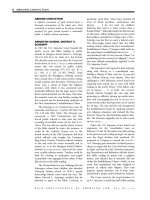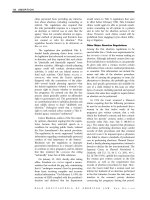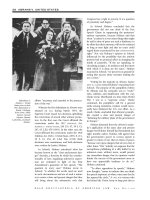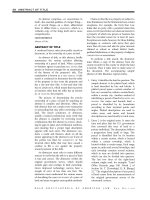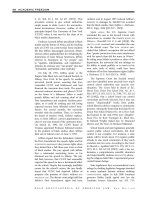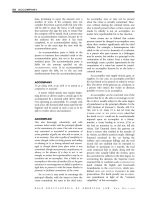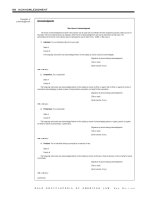Gale Encyclopedia Of American Law 3Rd Edition Volume 1 P40 pptx
Bạn đang xem bản rút gọn của tài liệu. Xem và tải ngay bản đầy đủ của tài liệu tại đây (364.32 KB, 10 trang )
among general audiences. The NEH provides
support through outright grants, matching
grants, and a combination of the two. Schools,
higher education institutions, libraries, museums,
historical organizations, professional associa-
tions, other cultural institutions, and individuals
are eligible to apply for NEH grants.
One avenue members of Congress use to
support the arts is the Congressional Arts
Caucus. This bipartisan group, composed of
nearly 250 members of Congress who recognize
and support the arts, acts as an information
clearinghouse on arts issues. The caucus reports
on legislation affecting artists and arts institu-
tions, both commercial and nonprofit. It helps
members of Congress prepare
TESTIMONY and
speeches on the arts.
The government also provides indirect aid
designed to create a heightened public aware-
ness of art and to provide artists with new outlets
for their work. Among the effective means of
indirect aid are the regulations adopted by many
state and municipal governments, which require
a percentage of the cost of building new
government structures to be spent on art.
Federal, state, and local governments indi-
rectly promote a heightened public awareness of
the arts in the community through zoning.
Zoning laws divide a city into districts and set
forth the types of structural and architectural
designs of buildings in those districts, and the
uses that buildings may serve. Some zoning
regulations and laws are designed to preserve
the aesthetic features or values of an area. As of
2003, most state courts allowed the use of
zoning laws for solely aesthetic purposes. These
laws may, for example, restrict the placement of
billboards or television satellite dishes or may
require that junkyards be screened or fenced.
State and local governments have become
involved in improving the appearance of
publicly funded buildings, or any building built
on public land, by requiring that new building
designs and locations be approved by the local
government. Local control over design was held
constitutional in Walnut & Quince Streets Corp.
v. Mills, 303 Pa. 25, 154 A. 29, appeal dismissed,
284 U.S. 573, 52 S. Ct. 16, 76 L. Ed 498 (1931).
In Walnut & Quince Streets, a municipal arts
panel refused to permit a theater owner to
construct a large marquee extending over the
sidewalk. The owner unsuccessfully argued that
a local statute permitted the jury to act in an
arbitrary fashion that deprived him of
DUE
PROCESS OF LAW
and, furthermore, that the
legislature did not have the authority to regulate
aesthetics and thus could not delegate such
authority to an “arts jury.” The court upheld the
statute as a legitimate legislative regulation of
public property.
Many governments have enacted statutes
and regulations prohibiting the destruction
and alteration of historic la ndmarks.
LANDMARK
preservation laws indirectly aid the arts by in-
creasing the public’s awareness of the need for
beautification and for preserving the work of
past generations of artists. The earliest efforts
to preserve the nation’s heritage focused on
particular buildings or national monuments.
The application of historic preservation laws to
limit a property owner’s right to her or his
property was declared constitutional in Penn
Central Transportation Co. v. New York City, 438
U.S. 104, 98 S. Ct. 2646, 57 L. Ed. 2d 631
(1978). In Penn Central, the U.S. Supreme
Court held that the New City Landmarks
Preservation Commission’s failure to approve
plans for construction of a 50-story office build-
ing over Grand Central Terminal, a designated
landmark, was not an unconstitutional taking
of property.
Historic preservation law is an active and
expansive area of zoning and planning law.
According to the National Trust for Historic
Preservation, more than 1,700 communities have
enacted preservation laws. Federal efforts to
encourage preservation include the enactment
of laws providing some tax credits for the
protection and restoration of old buildings (26
U.S.C.A. § 48 (g)(3)(A) [1986]) and for the
protection of archaeological sites (16 U.S.C.A. §
461[1986]).
FURTHER READINGS
Brenson, Michael. 2001. Visionaries and Outcasts: The NEA,
Congress, and the Place of the Visual Artist in America.
New York: New Press.
Ellickson, Robert C., and Vicki L. Been. 1985. Land-Use
Controls: Cases and Materials. Frederick, MD: Aspen.
Frohnmayer, John E. 1992. “A Litany of Taboo,” Kansas
Journal of Law and Public Policy 2 (spring).
Hulbert, Dan. 1998. “High Court Upholds NEA Decency
Standards.” Atlanta Journal-Constitution (June 26).
Rathkopf, Arden H., and Daren A. Rathkopf. 2005.
Rathkopf’s The Law of Zoning and Planning. 5th ed.
St. Paul, MN: Thomson/West.
U.S. Congress. Congressional Arts Caucus. Serial 20515.
GALE ENCYCLOPEDIA OF AMERICAN LAW, 3RD E DITION
378 ART LAW
CROSS REFERENCES
Helms, Jesse Alexander, Jr.; Land-Use Control; Zoning.
v
ARTHUR, CHESTER ALAN
Chester Alan Arthur was born October 5, 1830,
in Fairfield, Vermont. He achieved prominence
as a politician and as
PRESIDENT OF THE UNITED
STATES
.
An 1848 graduate of Union College, Arthur
was admitted to the New York City bar in 1851,
and he established a legal practice in New York
City that same year.
With the onset of the Civil War, Arthur
served as quartermaster general and inspecto r
general of New York. After the war, from 1871
to 1878, he performed the duties of collector for
the Port of New York. Although Arthur was a
believer in the spoils system, a practice that
rewards loyal political party members with jobs
that require official appointment, he served his
office as an honest administrator. President
RUTHERFORD B. HAYES was, however, an advocate
of the
CIVIL SERVICE system, which provided that
qualified people receive employment fairly
based upon their qualifications, and removed
Arthur from the office of collector.
Arthur returned to politics with his election
as
VICE PRESIDENT of the United States in March
of 1880. In Septemb er 1881, he assumed the
duties of president, after the assassination of
President
JAMES GARFIELD.
As president, Arthur advocated the passage
of the Pendleton Civil Service Reform Bill in
1883, adopting a view that was contrary to his
previous support of the spoils system. He signed
laws allowing for the modernization of the United
States Navy and supported the prosecution of
the Star Route Trials, which exposed fraudu-
lent activities in the United States Post Office
Department. He also vetoed a Congressional
bill, the Rivers and Harbours Bill of 1882,
charging that the allotment of funds was too
extravagant.
Arthur’s presidential term ended in 1885; due
to ill health, he did not seek renomination. He
died November 18, 1886, in New York, New York.
ARTICLES
Series or subdivisions of individual and distinct
sections of a document, statute, or other writing, such
as the Articles o f Confederation. C odes or systems
of rules created by written agreements of parties
or by statute that establish standards of legally
Chester Alan Arthur 1830–1886
◆❖
◆
◆◆❖
1830 Born,
Fairfield, Vt.
1829 Andrew
Jackson became
7th U.S. president
1848 Graduated
from Union
College
1851 Passed NYC bar and
established legal practice
1861–65 Served as
quartermaster
general and inspector
general of New York
during Civil War
1880 Elected vice president under James Garfield
1871–78
Served as
collector for
the Port of
New York
1881–1885 Served as 21st U.S. president
after assassination of Garfield
1883 Signed Pendleton Civil
Service Reform Bill into law
1886 Died,
New York City
▼▼
▼▼
18001800
18501850
18751875
19001900
18251825
◆
Chester A. Arthur.
LIBRARY OF CONGRESS
MEN MAY DIE, BUT
THE FABRIC OF FREE
INSTITUTIONS
REMAINS UNSHAKEN
.
—CHESTER ARTHUR
GALE ENCYCLOPEDIA OF AMERICAN LAW, 3RD E DITION
ARTICLES 379
acceptable b ehavior in a bus i ness relationsh i p, such
as articles of incorporation or articles of partnership.
Writings that embody contractual terms of agree-
ments between parties.
ARTICLES OF CONFEDERATION
The document that set forth the terms under
which the original thirteen states agreed to parti-
cipate in a centralized form of government, in
addition to their self-rule, and that was in effect
from March 1, 1781, to March 4, 1789, prior to
the adoption of the Constitution.
The
ARTICLES OF CONFEDERATION served as the
first constitution of the newly formed United
States. As it was originally drafted in 1776,
the document provided for a strong central
government. However, by the time it was
ratified in 1781, advocates of states’ rights had
greatly weakened its provisions. Many of these
advocates feared a centralization of power
and wished to preserve a great degree of
independence and
SOVEREIGNTY for each state.
Accordingly, the Articles as they were ratified
provided only for a “firm league of friendship,”
in which, according to article II of the
document, “[e]ach State retains its sovereignty,
freedom and independence.”
The Articles included provisions for military
cooperation between the states, freedom of
travel,
EXTRADITION of criminal suspects, and
equal
PRIVILEGES AND IMMUNITIES for ci tizens.
They also created a national legislature called
the Congress. Each state had one vote in this
body, that vote to be determined by a delegation
of from two to seven representatives. The
Articles called for Congress to conduct foreign
relations, maintain a national army and navy,
establish and maintain a postal service, and
perform a number of other duties. The Articles
did not create, as the Constitution later did,
executive and judicial branches of government.
The Congress created by the Articles was
successful on a number of fronts. In 1783 it
negotiated with Great Britain a peace treaty that
officially ended the Revolutionary War; it
arranged to pay war debts; and it passed the
NORTHWEST ORDINANCE, which allowed for settle-
ment and statehood in new regions in the
western part of the United States. However,
with time, it became apparent that the Articles
had created an unsatisfactory union of the
states, chiefly because they established a weak
central government. For example, under the
Articles of Confederation, Congress did not
have the power to tax or to effectively regulate
commerce. The resu lting national government
did not prove competent at such tasks as raising
a military or creat ing a stable currency. In
addition, because amendments to the Articles
required a unanimous vote of all thirteen states ,
the Articles proved to be too inflexible to last.
A series of incidents in the 1780s made it
clear to many early U.S. leaders that the Articles
of Confederation would not serve as an effective
constitution. Among these incidents was Shays’s
Rebellion, in 1786 – 87, an insurrection in which
economically depressed farmers demanded debt
relief and closed courts of law in western
Massachusetts. The Congress of the Confedera-
tion was not able to raise a force to respond to
this civil unrest, which was later put down by a
state
MILITIA. GEORGE WASHINGTON and other
leaders perceived this as a grievous failure.
Therefore, when a constitutional convention
assembled in 1787 to amend the Articles, it
quickly decided to abandon them altogether in
favor of a new constitution. By June 21, 1788,
nine states had ratified the new U.S. Constitu-
tion and made it effective. It has survived as the
basis of U.S. government for more than 200
years.
FURTHER READINGS
Harrigan, John J . 1996. Politics and the American Future: Dile-
mmas of Democracy. 4th ed. New York: McGraw-Hill.
Kesavan, Vasan. 2002. “When Did the Articles of Confeder-
ation Cease to Be Law?” Notre Dame Law Review 78
(December).
Levy, Michael B. 1988. Political Thought in America: An
Anthology. 2d ed. Florence, KY: Brooks Cole.
CROSS REFERENCES
“Articles of Confederation” (Appendix, Primary Docu-
ment); Constitution; Constitution of the United States;
Federalism; Shays’s Rebellion; Washington, George.
ARTICLES OF IMPEACHMENT
Formal written allegations of the causes that
warrant the criminal trial of a public official
before a quasi-political court.
In cases of
IMPEACHMENT,involvingthe
president,
VICE PRESIDENT, or other federal officers,
the House of Representatives prepares the
ARTICLES OF IMPEACHMENT, because it is endowed
with the “sole Power of Impeachment,” under
Article I, Section 2, Clause 5 of the Constitution.
GALE ENCYCLOPEDIA OF AMERICAN LAW, 3RD E DITION
380 ARTICLES OF CONFEDERATION
The articles are sent to the Senate, which has the
exclusive power to “try all Impeachments” by
virtue of Article I, Section 3, Clause 6.
The use of articles of impeachment against
state officials is governed by state constitutions
and statutes. Articles of impeachment are anal-
ogous to an indictment that initiates criminal
prosecutions of private persons.
Articles of Impeachment and
the U.S. Presidency
Articles of impeachment have been drafted
against three U.S presidents,
ANDREW JOHNSON,
RICHARD M. NIXON, and WILLIAM JEFFERSON CLINTON.
Nixon resigned before the full House could vote
to approve the articles of impeachment pre-
pared by the judiciary committee, while John-
son and Clinton were both acquitted during
Senate trials that were bitterly divided along
party lines.
On February 24, 1868, the U.S House of
Representatives voted to
IMPEACH President
Andrew Johnson. A week later the House
approved 11 articles of impeachment, accusing
the president of
OBSTRUCTION OF JUSTICE, thwart-
ing duly enacted federal laws, improvidently
removing military governors from the southern
states, and attempting to bring into disgrace,
ridicule, hatred, contempt, and reproach the
CONGRESS OF THE UNITED STATES. Most historians
consider all of the charges against Johnson to
have been politically motivated, as the House of
Representatives was controlled by radical
Republicans who favored
RECONSTRUCTION Era
legislation that Johnson opposed.
In August 1867, Johnson tried to remove the
last staunch Reconstructionist from his cabinet
by dismissing Secretary of War
EDWIN STANTON
and replacing him with General ULYSSES S. GRANT.
The Senate refused to approve the dismissal,
so Johnson replaced Stanton with another
general. One article of impeachment charged
that Stanton’s dismissal violated the
TENURE
OF OFFICE ACT
, which prohibited the president
from dismissing cab inet members without the
Senate’s approval.
Johnson’s trial in the Senate commenced
March 13, 1868, and lasted until May 26, 1868.
Supreme Court Justice Salmon Chase presided.
The Senate consisted of 45 Republicans and
only nine Democrats. Thirty-six votes were
required for conviction, so a party-line vote
would easily have removed Johnson. After
voting on the first three articles of impeachment
and failing to convict by a single vote on each of
them (7 Republicans sided with 12 Democrats),
the Senate adjourned without considering the
other eight articles.
On July 27, 1974, the House Judiciary
Committee approved three articles of impeach-
ment against President Richard M. Nixon. The
articles charged the president with obstruction
of justice in trying to cover up the
BURGLARY of
DEMOCRATIC PARTY offices at the WATERGATE
complex in Washington, D.C., ABUSE OF POWER
for ordering the INTERNAL REVENUE SERVICE (IRS)
to audit the taxes of political adversaries, and
refusal to obey a
SUBPOENA from the Judiciary
Committee. A week later Nixon complied with
a Supreme Court order compelling him to
release the transcripts of three tape-recorded
conversations of June 23, 1972, which demon-
strated his involvement in, and knowledge of,
the Watergate cover-up.
For example, the transcript of June 23, 1972,
tape showed H. R. Haldeman, White House
Chief of Staff, telling Nixon that campaign
money had financed the Watergate burglary and
Nixon telling Haldeman to use the
CENTRAL
INTELLIGENCE AGENCY
(CIA) to curb a FEDERAL
BUREAU OF INVESTIGATION
(FBI) investigation of
the money trail. This transcript was widely
referred to as the “the smoking gun” tape
because some Republicans had said they would
not support impeachment until they found
evidence of Nixon holding a “smoking gun” of
guilt in his hand. With the public turning
against Nixon and his approval rating hovering
around twenty-five percent, Republican con-
gressional leaders and some of the president’s
own aides put him under enormous pressure to
resign. Three days after the tapes were released
to the public, on August 8, 1974, President
Nixon resigned. Nixon’s resignation ended the
impeachment inquiry, and following his resig-
nation, President
GERALD FORD pardoned Nixon
for all crimes he may have committed as the
nation’s chief executive.
On December 19, 1998, the U.S. House of
Representatives approved two articles of impeach-
ment against D emocratic president Clinton,
accusing the president of having committed the
crimes of
PERJURY and obstruction of justice to
conceal his relationship with former White-House
intern Monica Lewinsky. The impeachment trial
GALE ENCYCLOPEDIA OF AMERICAN LAW, 3RD E DITION
ARTICLES OF IMPEACHMENT 381
before the Senate began on January 7 , 1999, and
ended on February 12, 1999. Chief Justice WILLIAM
REHNQUIST
presided.
Like the impeachment trial of Andrew
Johnson, the Clinton impeachment trial was
also bitterly divided along party lines. The
Senate was composed of 55 Republicans and
45 Democrats. However, several moderate
Republicans privately questioned the propriety
of impeaching a president whose job-approval
ratings were at approximately 70 percent during
a period when the
STOCK MARKET was experienc-
ing strong growth. Enough Republicans eventu-
ally joined all 45 Demo crats in voting to
ACQUIT
the president on both articles of impeachment,
neither article being supported by even a
majority of votes, far short of the 67 votes
required to convict.
FURTHER READINGS
Bowman, Frank O. III. 2001. “Falling Out of Love with
America: The Clinton Impeachment and the Madiso-
nian Constitution.” Maryland Law Review 60.
Collier, Charles W., and Christopher Slobogin. 1999.
“Terms of Endearment and Articles of Impeachment.”
Florida Law Review 51 (September).
Pious, Richard M. 1998. “The Constitutional and Popular
Law of Presidential Impeachment.” Presidential Studies
Quarterly 28.
CROSS REFERENCES
Chase, Samuel, “The Samuel Chase Impeachment Trial”
(Sidebar); Impeachment, “How Will the Trial of Bill
Clinton Affect Future Impeachments?” (In Focus); Im-
peachment, “A Challenge to I mpeachment” (Sidebar).
ARTICLES OF INCORPORATION
The document that must be filed with an
appropriate government agency, commonly the
office of the secretary of state, if the owners of a
business want it to be given legal recognition as a
corporation.
Articles of incorporation, sometimes called
a certificate of incorporation, must set forth
certain information as mandated by statute.
Although laws vary from state to state, the
purposes of the corporation and the rights and
liabilities of shareholders and directors are
typical provisions required in the document.
Official forms are prescribed in many states.
Once the articles of incorporation are filed
with the
SECRETARY OF STATE, corporate existence
begins. In some jurisdictions, a formal certifi-
cate of incorporation attached to a duplicate of
the articles must be issued to the applicant
before the business will be given legal status as a
corporation.
ARTICLES OF ORGANIZATION
A document required to be filed with an
appropriate state or local government agency, in
order to establish legal recognition of a limited
liability company (LLC). Articles of organization
closely parallel articles of incorporation needed for
legal creation and recognition of corporations.
Limited liability companies and corpora-
tions are creatures of statute. They do no exist,
in the eyes of the law, until articles of
organization or incorporation have been prop-
erly filed and accepted by the designated
governmental agency—commonly the office of
the
SECRETARY OF STATE. A business owner is free
to set up a LLC in any state; however, the state
chosen becomes the state of domicile for such
purposes as jurisdiction, employee and with-
holding taxes, and required annual filings.
Prior to filing articles of organization, a
business owner must che ck with the state in
which the articles will be filed to determine the
availability of the chosen name for the new
business entity. Most states do not require a
specific format for the articles of organization. All
states, however, do require specific minimum
information to be contained within the articles.
The required information includes the name of
the new entity; the business form (e.g., LLC); a
statement of general purpose; the name and
address of an agent for
SERVICE OF PROCESS;the
form(s) of ownership interest (e.g., equitable
and non-equitable ownership, voting and non-
voting ownership, and other forms of ownership
having different preferences. Limitations, rights,
or duties); and the name(s) of i nitial owner(s) and
manager(s). Standa rd forms a re available in ma ny
states, which need only be completed and filed
along with the corresponding administrative fee.
FURTHER READINGS
Max Filings, Inc. Web site. “Q&A: Limited Liability
Companies (LLCs).” Available online at http://www.
maxfilings.com/incorporation-knowledge-center/QA-
limited-liability-companies-llc.php; website home page:
(accessed July 5, 2009).
Straub, Joseph T., and Raymond F. Attner. 1994. Introduc-
tion to Business. 5th ed. Belmont, CA: Wadsworth.
Toolkit Media Group Web site. 1995–2009. “Filing the
Articles of Organization.” Available online at http://
www.toolkit.com/small_busine ss_guide/sbg.aspx?
nid=P12_6825; website home page: lkit.
com (accessed July 5, 2009).
GALE ENCYCLOPEDIA OF AMERICAN LAW, 3RD E DITION
382 ARTICLES OF INCORPORATION
Articles of Incorporation (For-Profit Corporation)
:SNOITCURTSNI
STEP 1: CONTACT THE OFFICE OF THE SECRETARY OF STATE AT (334)242-5324 TO RESERVE A CORPORATE NAME.
STEP 2: TO INCORPORATE, FILE THE ORIGINAL, TWO COPIES OF THE ARTICLES OF INCORPORATION AND THE CERTIFICATE OF NAME
RESERVATION IN THE COUNTY WHERE THE CORPORATION’S REGISTERED OFFICE IS LOCATED. THE SECRETARY OF STATE’S
FILING FEE IS $40. PLEASE CONTACT THE JUDGE OF PROBATE TO VERIFY FILING FEES.
PURSUANT TO THE PROVISIONS OF THE ALABAMA BUSINESS CORPORATION ACT, THE UNDERSIGNED HEREBY ADOPTS THE
FOLLOWING ARTICLES OF INCORPORATION.
IELCITRA
The name of the corporation:
IIELCITRA
The duration of the corporation is “perpetual” unless otherwise stated.
IIIELCITRA
The corporation has been organized for the following purpose(s):
VIELCITRA
The number of shares which the corporation shall have the authority to issue is
VELCITRA
The street address (NO PO BOX) of the registered office:
and the name of the registered agent at that office:
IVELCITRA
The name(s) and address(es) of the Director(s):
IIVELCITRA
The name(s) and address(es) of the Incorporator(s):
Any provision that is not inconsistent with the law for the regulation of the internal affairs of the corporation or for the restriction of the
transfer of shares may be added.
IN WITNESS THEREOF, the undersigned incorporator executed these Articles of Incorporation
on this the _____________________ day of _______________, 20____.
Type or Print Name of Incorporator
Signature of Incorporator
Printed Name and Business Address of Person Preparing this Document:
Rev. 7/03
.
.
.
.
An example of for-
profit articles of
incorporation
ILLUSTRATION BY GGS
CREATIVE RESOURCES.
REPRODUCED BY
PERMISSION OF GALE,
A PART OF CENGAGE
LEARNING.
ARTICLES OF INCORPORATION 383
GALE ENCYCLOPEDIA OF AMERICAN LAW, 3RD E DITION
CROSS REFERENCES
Articles of Incorporation; Jurisdiction.
ARTICLES OF PARTNERSHIP
A written compact by which parties agree to pool
their money, labor, and/or skill to carry on a
business for profit. The parties sign the compact
with the understanding that they will share
proportionally the losses and profits according to
the provisions and conditions that they have
mutually assented would govern their business
relationship.
CROSS REFERENCE
Partnership.
ARTICLES OF WAR
Codes created to prescribe the manner in which
the armed services of a nation are to be governed.
For example, the
UNIFORM CODE OF MILITARY
JUSTICE
is an article of war applied to the Army,
the Navy, the Coast Guard, and the Air Force of
the United States.
CROSS REFERENCE
Military Law.
ARTIFICIAL INSEMINATION
The process by which a woman is medically
impregnated using semen from her husband or
from a third-party donor.
Artificial insemination is employed in cases
of infertility or impotence, or as a means by
which an unmarried woman may become
pregnant. The procedure, which has been used
since the 1940s, involves injecting collected
semen into the woman’s uterus and is per-
formed under a physician’s supervision.
Artificial insemination raises a number of
legal concerns. Most states’ laws provide that a
child born as a result of artificial insemination
using the husband’s sperm, referred to as AIH,
is presumed to be the husband’s legal child.
When a child is born after artificial insemina-
tion using the sperm of a third-party donor,
referred to as AID, the law is less clear. Some
states stipulate that the child is presumed to be
the legal child of the mother and her husband,
whereas others leave open the possibility that
the child could be declared illegitimate.
Artificial insemination has grown in popu-
larity as infertility becomes more prevalent and
as more women opt to become single mothers.
Eighty thousand such procedu res using donor
sperm are performed each year, resulting in the
births of thirty thousand babies. By 1990
artificial insemination was a $164 million
industry involving eleven thousand private
physicians, four hundred sperm banks, and
more than two hundred fertility centers.
The pract ice of artificial insemination is
largely unregulated, and secrecy surrounding
the ident ity of donors and recipients is the
norm. Surveys of parents indicate that most do
not plan to tell their children the circumstances
of their births. This raises ethical questions
about the right of an individual to be informed
about his or her heritage. People who inadver-
tently discover they were conceived through
artificial insemination often experience distress
and feelings of confused identity. Many doctors
compound the problem by failing to keep
records on the identities and medical histories
of donors.
The legal minefield created by artificial
insemination continues to erupt with new and
unprecedented issues. In 1990 Julia Skolnick
sued a fertility clinic and a sperm bank for
NEGLIGENCE and MEDICAL MALPRACTICE, charging
that they mistakenly substituted another man’s
sperm for that of her late husband. The woman,
who is white, gave birth to a child with African
American features, and DNA analysis confirmed
that her husband, who was also white, could not
have been the child’s father. In another case,
Junior Lewis Davis sued to prevent his ex-wife,
Mary Sue Davis Stowe, from using or donating
fertilized embryos the couple had frozen for
later use. The Tennessee Supreme Court held
that individuals have “procreational autonomy”
and have the right to choose whether to have a
child (Davis v. Davis, 842 S.W.2d 588 (Tenn .
June 1992). Arthur L. Caplan, former director
of the Center for Biomedical Ethics at the
University of Minnesota, commented, “In this
case, the court said that a man cannot be made
to become a parent against his will.” The Davis
case raises the question of the right of a sperm
donor to prevent the use of his sperm by
specific individuals.
Serious health questions also surround the
issue of artificial insemination. AIDS, hepatitis,
and other infectious diseases pose risks to
women undergoing the procedure and their
potential children. Although the American
GALE ENCYCLOPEDIA OF AMERICAN LAW, 3RD E DITION
384 ARTICLES OF PARTNERSHIP
Fertility Society recommends that donors be
tested for infectious diseases, the guidelines are
not binding. In fact, some doctors merely
request that donors answer questions about
their health history and sex life, and only a
handful of states require testing. This casual
approach to donor screening can lead to
disaster. In 1994 Mary Orsak, of Downey,
California, sued the Tyler Medical Clinic, in
Westwood, California, for negligence when she
discovered she was HIV-positive as a result of
artificial insemination with donor sperm. In at
least six other cases, HIV transmission through
artificial insemination has been confirmed.
Other legal pitfalls open up as technology
makes artificial insemination more sophisti-
cated and more available. Because sperm can
be frozen for future use, a woman can be
impregnated at any time, even after her hus-
band’s death. In 1990 Nancy Hart and Edward
Hart, of Covington, Louisiana, anticipating that
Edward might not survive his bout with cancer
and knowin g that chemotherapy might leave
him sterile, decided to place a sample of his
sperm in a New Orleans sperm bank. Edward
died in June 1990. Three months later Nancy
underwent artificial insemination using his
sperm, and on June 4, 1991, their daughter
Judith was born. Under Louisiana law (L.S.A
C.C. Art. 185), the state would not acknowledge
Edward as the child’s father because she had
been born more than three hundred days after
his death. As a result, Nancy was unable to
receive
SOCIAL SECURITY survivors benefits for
her daughter. She sued both the state of
Louisiana and the federal government. In June
1995 Administrative Law Judge Elving Torres
ruled that the Social Security Administration
(SSA) must pay Judith a $10,000 lump sum and
$700 per month in survivor’s benefits. Accord-
ing to Torres, the
DNA EVIDENCE presented to
him proved that Judith is Nancy and Edward
Hart’s child.
Medical technology enables recipients of
artificial insemination to select the sex of their
offspring, which raises still more ethical ques-
tions. Some religions condemn this practice as
unnatural, although other theologians disagree.
Some commentators have even suggested that it
is unethical and exploitative to offer expensive,
difficult, painful, and frustrating fertility proce-
dures to desperate people when there may be
little chance that a successful pregnancy will
result.
The legal, ethical, and medical quagmires
created by artificial insemination have not deter-
red thousands of couples and single women
from seeking the procedure. Artificial insemi-
nation is sometimes the best, if not the only,
solution for a person determined to achieve
pregnancy.
FURTHER READINGS
Bernstein, Gaia. 2002. “The Socio-Legal Acceptance of New
Technologies: A Close Look at Artificial Insemination.”
Washington Law Review 77 (October).
Goldstein, Karen L., and Caryn H. Okinaga. 2002. “Assisted
Reproductive Technology.” Georgetown Journal of
Gender and the Law 3 (spring).
Gunning, Jennifer, and Helen Szoke, eds. 2003. The Regu-
lation of Assisted Reproductive Technology. Aldershot,
Hampshire, England: Ashgate.
Ross, Jane O. 1999. “A Legal Analysis of Parenthood by
Choice, Not Chance.” Texas Journal of Women and the
Law 9 (fall).
CROSS REFERENCES
Family Law; Illegitimacy; Parent and Child; Reproduction.
ARTIFICIAL PERSON
A legal entity that is not a human being but for
certain purposes is considered by virtue of statute
to be a natural person.
A corporation is considered an
ARTIFICIAL
PERSON
for SERVICE OF PROCESS.
AS IS
A term used to describe a sales transaction in
which the seller offers goods in their present,
existing condition to prospective buyers.
The term as is gives notice to buyers that
they are taking a risk on the quality of the
goods. The buyer is free to inspect the goods
before purchase; but if any hidden defects are
discovered after purchase, the buyer has no
recourse against the seller. Any implied or
express warranties that usually accompany
goods for sale are excluded in an “as is” sale.
Contract law and the
UNIFORM COMMERCIAL CODE
regulate “as is” sales.
AS PER
A phrase commonly recognized to mean “in
accordance with the terms of” a particular
document—such as a contract, deed, o r affidavit—
or “as authorized by the contract.”
GALE ENCYCLOPEDIA OF AMERICAN LAW, 3RD E DITION
AS PER 385
v
ASHCROFT, JOHN DAVID
In 25 years, JOHN ASHCROFT ascended from
assistant state attorney general for the state of
Missouri to U.S. attorney general. The political
road to the
JUSTICE DEPARTMENT was paved by this
conservative right-wing Republican with his
hard work and strong ethics.
JOHN DA VID ASHCROFT wasbornonMay9,
1942, in Chicago, Illinois. His family moved to
rural S pringfield, Missouri, when he was j ust a
young boy. Springfield is the home of the
Pentecostal Assembly of God Church, and because
Ashcroft’s f ather and grandfather were Pentecostal
ministers, it seemed only natural that the family
would make Springfield their home. Whereas the
church forbids smoking, drinking, and dancing, it
does promote gospel singing. Ashcroft t ook up
playing the guitar and singing gospel when he was
young, and i t was a passion of his e ver a fter.
After high school Ashcroft headed east to
Yale where he received a degree in history in
1964. He then returned to the Midwest and
studied at the University of Chicago Law
School. There he met his later wife, Janet. They
both graduated from the University of Chicago
in 1967 and went on to teach business law at
Southwest Missouri State University.
In 1972 Ashcroft decided to run for a spot
in the U.S. House of Representatives. While he
lost the race, he still found his way into politics
when he was named assistant attorney general
for the state of Missouri in 1975 under then-
attorney general, John Danforth. While working
there, Ashcroft met future U.S. Supreme Court
Justice
CLARENCE THOMAS.
In 1976 Danforth decided to run for the
U.S. Senate, giving Ashcroft the opportunity to
campaign for the soon-to-be vacated state
attorney general position. Ashcroft won the
election and, in this new role, established his
conservative reputation when he vehemently
opposed court-ordered
SCHOOL DESEGREGAT ION in
St. Louis and Kansas City. While he could not
please everybody, he managed to please many,
and he was elected for another term befo re then
becoming the 50th governor of Missouri in
1984.
Ashcroft accomplished a great deal for the
state of Missouri. He balanced budgets without
increasing taxes. He also fo cused on
WELFARE
reform and education by imposing tougher
testing requirements for student advancement.
As a validation of these efforts, Ashcroft was
John Ashcroft.
GETTY IMAGES
John David Ashcroft 1942–
▼▼
▼▼
1925
2000
1975
1950
❖
◆
◆
◆◆
1942 Born in
Chicago, Illinois
1939–45
World War II
1967 Received J.D.
from University of Chicago
1961–73
Vietnam War
1976–85
Served as Missouri
attorney general
1985–93
Served as
Missouri governor
2001 Became
U.S. attorney
general
1995–2000
Served as U.S.
senator from
Missouri
2001 September
11 terrorist attacks
2005 Founded The Ashcroft Group
◆
2004 Resigned as attorney general
GALE ENCYCLOPEDIA OF AMERICAN LAW, 3RD E DITION
386 ASHCROFT, JOHN DAVID
re-elected to a second term as governor with an
impressive 65 percent of the vote. State law did
not allow him to run for a third term.
In 1994 Ashcroft again followed in the
footsteps of John Danf orth, who was retiring
from the Senate. Ashcroft was elected to the
U.S. Senate and sworn in at the beginning of
1995. While in Congress, Ashcroft proposed
and supported very conservative legislation,
most of which did not become law. He was
pro-life, against
GUN CONTROL, and against
AFFIRMATIVE ACTION. He sponsored the Human
Life Amendment, which defined life to begin at
conception and banned all abortions, including
those involving incest or
RAPE, except when
needed to save the life of the mother. The
legislation did not become law. He was also
unsuccessful in his support for term limits for
congressmen and prayer in schools. Ashcroft
was, however, successful with his Char itable
Choice provision, a component of the welfare
reform legislation in 1996. The provision
granted funding to religious organizations in
order to provide social welfare programs.
In 1998 Ashcroft published a book, Lessons
from a Father to His Son, about his father’s
preachings, his Christian faith, and how it
influenced his life. Also in 1998 the Ronnie
White confirmation hearings branded him by
some as a racist. White was the first African
American Missouri Supreme Court Justice.
Then-president
BILL CLINTON nominated him to
the federal bench. During White’s confirmation
hearings, Ashcroft focused on a dissent that
White made in a
CAPITAL PUNISHMENT case and
argued that White was soft on crime. Yet White
had actually voted to upho ld the death penalty
in 41 of the 59 cases that he heard on the bench,
and some argued that Ashcroft attacked White
because of his race. Ultimately, the Senate voted
down White, making him the first federal
judicial nominee to be defeated since Robert
Bork. That same year, Ashcroft seriously
considered running for the
REPUBLICAN PARTY
nomination for U.S. president. After a short-
lived campaign, however, he withdrew his name
and supported
GEORGE W. BUSH.
In 2000, Ashcroft ran once again for his
Senate position, this time against Missouri
governor Mel Carnahan. Carnahan died with
his son in a plane crash three weeks before the
election but still won the vote by a slim margin.
Ashcroft was a gracious loser, and Carnahan’s
widow was appointed to replace her deceased
husband in the Senate.
In 2001 Ashcroft was appointed by Presi-
dent Bush and confirmed by Congress for the
position of U.S. attorney general, one of the
most powerful positions in the country. As
attorney general, Ashcroft became head of the
Justice Department and would oversee many
powerful segments of the federal government,
including the
DRUG ENFORCEMENT ADMINIST RATION,
the FEDERAL BUREAU OF INVESTIGATION, and the U.S.
Marshals.
The
SEPTEMBER 11TH ATTACKS in 2001 caused
an enormous change in the way Americans
viewed the responsibilities of the nation’s top
law enforcement officials. In the aftermath of
the attacks, Congress passed the Homeland
Security Act and the USA Patriot Act, legislation
that gave the Justice Department unprecedented
latitude in dealing with suspected terrorists. In
2002 and early 2003, Ashcroft issued numerous
regulations dealing with the issue of domestic
security and the tracking of foreign nationals
including orders that gave FBI agents and U.S.
marshals permission to arrest such persons for
IMMIGRATION violations when there was not
sufficient evidence to hold the m on criminal
charges. The Justice Department stepped up its
surveillance methods, including the issuance of
“national security letters” that mandated busi-
nesses to turn over electronic records of
finances and other information. Ashcroft also
signed more than 170 classified “ emergency
foreign intelligence warrants,” which allowed
72 hour s of wiretaps and searches of persons
viewed as national security
THREATS before they
needed to be reviewed and approved by the
Foreign Intelligence Surveillance Court.
Groups representing Muslim immigrants,
numerous civil liberties advocates, religious
groups, and others protested much of the DOJ
activity. One program that did not pass muster
with Congress was the
TERRORISM Information
and Prevention System to be known by its
acronym as “Operation TIPS.” The program
was planned to train millions of American
workers including truck drivers, mail carriers,
train conductors, and employees of utilities to
look for and report any suspicious material or
activity to a new FBI database.
Other Ashcroft initiatives that provoked
controversy include the DOJ’schallengetoan
Oregon law that permits physician-assisted
OUR [ANTI-
TERRORIST] EFFORTS
HAVE BEEN CRAFTED
CAREFULLY TO AVOID
INFRINGING ON
CONSTITUTIONAL
RIGHTS
, WHILE
SAVING
AMERICAN LIVES.
—JOHN ASHCROFT
GALE ENCYCLOPEDIA OF AMERICAN LAW, 3RD E DITION
ASHCROFT, JOHN DAVID 387



